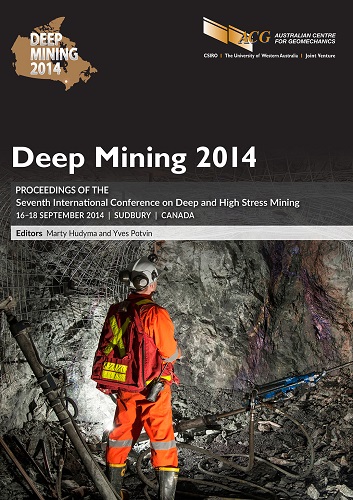Rock support testing in Luossavaara-Kiirunavaara AB's underground mines, Sweden

|
Authors: Swedberg, E; Thyni, F; Töyrä, J; Eitzenberger, A |
DOI https://doi.org/10.36487/ACG_rep/1410_07_Swedberg
Cite As:
Swedberg, E, Thyni, F, Töyrä, J & Eitzenberger, A 2014, 'Rock support testing in Luossavaara-Kiirunavaara AB's underground mines, Sweden', in M Hudyma & Y Potvin (eds), Deep Mining 2014: Proceedings of the Seventh International Conference on Deep and High Stress Mining, Australian Centre for Geomechanics, Perth, pp. 139-150, https://doi.org/10.36487/ACG_rep/1410_07_Swedberg
Abstract:
The mining company Luossavaara-Kiirunavaara AB (LKAB) operates two underground iron ore mines in Sweden. Both mines use large scale sublevel caving to extract the ore at a depth of nearly one kilometre and are, since 2008, regarded as seismically active. Rock support is therefore essential in order to maintain safe and accessible production areas. The support system used by LKAB primarily consists of steel fibre reinforced shotcrete together with external steel mesh and rockbolts. Accurate methods for design and testing of the support elements are important parts of ensuring the stability of the system. This paper explores three aspects of the design and testing of rock support, namely: Pull-out tests on rockbolts and stud penetration tests in a shotcrete liner were conducted in the field, while round determinate panel (RDP) tests were performed in a laboratory environment. RDP tests were performed on fibre reinforced shotcrete panels with and without external steel mesh, as well as shotcrete panels with and without steel fibres reinforced with embedded steel mesh. The pull-out tests show that it takes about 19 h for a grouted rebar bolt to achieve its failure load capacity, while it takes 15 h from application for the shotcrete liner to obtain about 70% of the required energy absorption. Results from the RDP tests indicate that the bearing capacity of a rock support system is highly influenced by the shotcrete thickness. Doubling the shotcrete thickness results in a threefold increase of the residual load capacity, suggesting that the residual strength increases with shotcrete thickness by a polynomial function. Shotcrete panels with embedded steel mesh are shown to be able to sustain higher peak loads compared to panels with external steel mesh in these tests. However, at large deflections the reverse occurs, i.e., the latter panel type has a higher load bearing capacity.
References:
ASTM International 2012, ASTM C1550: Standard Test Method for Flexural Toughness of Fiber Reinforced Concrete (Using Centrally Loaded Round Panel), ASTM International, West Conshohocken, viewed 14 June 2014,
Sjöberg, J, Lundman, P, Nordlund, E & Quinteiro, C 2003, ‘Stability analysis of ore passes in the Kiirunavaara mine’, Proceedings of the 10th Congress of the ISRM – Technology Roadmap for Rock Mechanics, vol. 2, South African Institute of Mining and Metallurgy, pp. 1093-1098.
Swedberg, E 2013, ‘Early Strength of Shotcrete and Fully Grouted Rockbolts’, in Swedish, Masters thesis, Luleå University of Technology, Luleå.
Swedish Standards Institute 2006, SS-EN 14488-2: Testing sprayed concrete - Part 2: Compressive strength of young sprayed concrete, Swedish Standards Institute, Stockholm, viewed 14 June 2014,
Thyni, F 2014, ‘Design of Shotcrete for Dynamic Rock Support by Static Testing’, Masters thesis, Luleå University of Technology, Luleå.
© Copyright 2025, Australian Centre for Geomechanics (ACG), The University of Western Australia. All rights reserved.
View copyright/legal information
Please direct any queries or error reports to repository-acg@uwa.edu.au
View copyright/legal information
Please direct any queries or error reports to repository-acg@uwa.edu.au